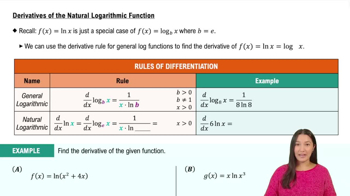Table of contents
- 0. Functions7h 52m
- Introduction to Functions16m
- Piecewise Functions10m
- Properties of Functions9m
- Common Functions1h 8m
- Transformations5m
- Combining Functions27m
- Exponent rules32m
- Exponential Functions28m
- Logarithmic Functions24m
- Properties of Logarithms34m
- Exponential & Logarithmic Equations35m
- Introduction to Trigonometric Functions38m
- Graphs of Trigonometric Functions44m
- Trigonometric Identities47m
- Inverse Trigonometric Functions48m
- 1. Limits and Continuity2h 2m
- 2. Intro to Derivatives1h 33m
- 3. Techniques of Differentiation3h 18m
- 4. Applications of Derivatives2h 38m
- 5. Graphical Applications of Derivatives6h 2m
- 6. Derivatives of Inverse, Exponential, & Logarithmic Functions2h 37m
- 7. Antiderivatives & Indefinite Integrals1h 26m
- 8. Definite Integrals4h 44m
- 9. Graphical Applications of Integrals2h 27m
- 10. Physics Applications of Integrals 2h 22m
4. Applications of Derivatives
Differentials
Problem 60
Textbook Question
Evaluate the following limits. Use l’Hôpital’s Rule when it is convenient and applicable.
lim_x→1⁻ (x/(x-1) - x/(ln x)
 Verified step by step guidance
Verified step by step guidance1
First, identify the form of the limit as x approaches 1 from the left. Substitute x = 1 into the expression (x/(x-1) - x/(ln x)) to check if it results in an indeterminate form like 0/0 or ∞/∞.
Notice that as x approaches 1 from the left, both the terms x/(x-1) and x/(ln x) approach forms that could lead to an indeterminate expression. Specifically, x/(x-1) approaches 1/0⁻ (negative infinity) and x/(ln x) approaches 1/0⁻ (negative infinity).
Since the limit results in an indeterminate form of ∞ - ∞, we can combine the fractions into a single fraction to apply l'Hôpital's Rule. Combine the terms over a common denominator: (x(ln x) - x(x-1)) / ((x-1)(ln x)).
Simplify the numerator: x(ln x) - x(x-1) = x ln x - x² + x. The expression becomes (x ln x - x² + x) / ((x-1)(ln x)).
Apply l'Hôpital's Rule, which is applicable for indeterminate forms like 0/0 or ∞/∞. Differentiate the numerator and the denominator separately with respect to x, and then evaluate the limit again as x approaches 1 from the left.
 Verified video answer for a similar problem:
Verified video answer for a similar problem:This video solution was recommended by our tutors as helpful for the problem above
Video duration:
11mPlay a video:
Was this helpful?
Key Concepts
Here are the essential concepts you must grasp in order to answer the question correctly.
Limits
Limits are fundamental in calculus, representing the value that a function approaches as the input approaches a certain point. They are essential for understanding continuity, derivatives, and integrals. In this question, evaluating the limit as x approaches 1 from the left involves analyzing the behavior of the function near that point.
Recommended video:

One-Sided Limits
l'Hôpital's Rule
l'Hôpital's Rule is a method for evaluating limits that result in indeterminate forms, such as 0/0 or ∞/∞. It states that if these forms occur, the limit of the ratio of two functions can be found by taking the derivative of the numerator and the derivative of the denominator. This rule simplifies the process of finding limits when direct substitution is not possible.
Recommended video:
Guided course

Power Rules
Natural Logarithm (ln)
The natural logarithm, denoted as ln, is the logarithm to the base e, where e is approximately 2.718. It is a crucial function in calculus, particularly in limits and derivatives. In this question, the presence of ln x in the limit expression indicates that understanding its behavior as x approaches 1 is vital for correctly applying l'Hôpital's Rule.
Recommended video:

Derivative of the Natural Logarithmic Function







